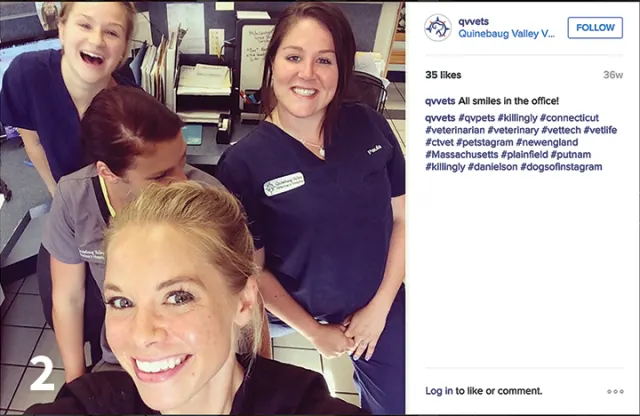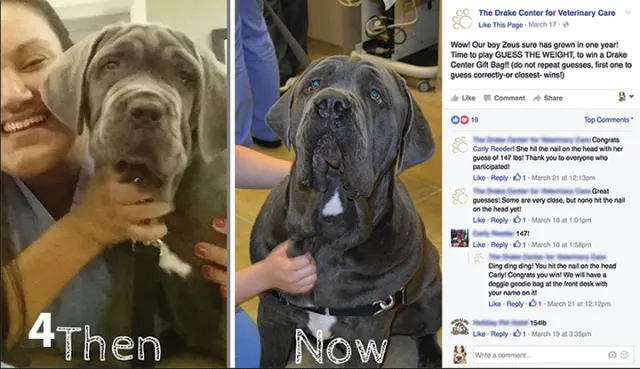Top 5 Ways to Use Social Media to Promote Your Practice
Danielle K. Lambert, SnoutSchool.com, Worcester, Massachusetts

With its countless platforms and constant changes, social media may seem daunting, especially to many veterinary professionals. But hiding behind a surgical mask and hoping it disappears will not change things.
Social media is used by 65% of adults, including 90% of those between the ages of 18 and 29 and 35% of those older than 65, so veterinary practices must get strategically social.1
This does not mean putting the practice's youngest team member in charge or outsourcing social media management. Following are the top 5 ways to use social media to promote your practice.
1. Create a Social Team Culture
Clients love your practice. Client service representatives always greet them with a smile, veterinary nurses always remember their pets name, and veterinarians always answer all their questions. These interactions establish a bond that keeps clients and patients returning.
A Facebook post celebrating a team members acceptance into veterinary school builds community and drives engagement. Social media posts courtesy of Snout School.


Instagram provides an authentic platform for showing off team members and their personalities. Social media posts courtesy of Snout School.
Social media can expand that bond from an annual appointment to every day of the year because clients will be able to engage with the team and the practice every time they check Facebook. But the posts must be authentic. (See Figures 1 & 2.) Team members diving under examination tables when the social media manager is attempting to take photos for Facebook will not help.
Develop a social practice culture. Convey social medias value to the whole team and involve each team member in developing a social media policy. Show the team how social media can educate clients about their pets and build client loyalty, and be sure to communicate to team members their role so they will stop avoiding the camera.
2. Use Surveys to Determine Your Focus
Use social media resources wisely and focus efforts only on the platforms your clients use most frequently.
A simple client survey can help. The survey can be forms clients are asked to complete when they check in, Survey Monkey online surveys, iPad survey apps, or Quick Tap app surveys. Ask clients Which social media platforms do you use frequently (ie, daily, weekly, monthly)? Make note of the answers (eg, Facebook, Instagram, Pinterest, Snapchat, Periscope, Twitter), and then focus on platforms used frequently by more than 30% of clients.
Client Consent Form
VTB Veterinary Practice loves making pets Facebook famous! Please give us your permission to share your pet(s)' image and story on social media, our website, and other marketing materials with your signature below. Your personal information will never be shared.
Date:___________ Signature:____________________________
3. Show Off Your Patients
Forget generic cat memes and cartoons show off the practices own patients. In the authors experience, social media posts should be about 80% patient photos and videos. Keep them positive, clean, and complimentary. Always get written client consent. (See Client Consent Form) Most veterinary clients are keen for Fluffy to be Facebook famous and they will be happy to allow team members to take photos during patient examinations.


Asking for comments on Facebook turns posts into the entertainment clients are searching for on social media. Social media posts courtesy of Snout School.
When posting patient photos, ensure social interaction with clients with simple, engaging questions such as such as Do you know what breed I am?
Also, easy graphic design tools are available to add text to graphics (eg, Canva, the Phonto app). (See Figures 3 & 4).
4. Make Education Fun
Few people log into Facebook to learn something. Clients are the same most go to social media to have fun, relax, and see what else is happening.
Build bonds by sharing updates on patients as they grow and change. Social media posts courtesy of Snout School.
A practice's social media posts must be client-focused. Offer pet care tips a client will share with a friend. About 20% of posts can be educational, but still make them fun and engaging; for example, post short quizzes, ask clients to engage, and give small prizes to clients who answer correctly. Also, link to educational resources (eg, blogs, journal articles). Beat Dr. Google by ensuring your clients know your practice is the resource for online information about their pet.
Make Social Media Part of the Practice Promotion Plan
Many veterinary practices do not know how to make a promotion and marketing plan or create advertisements. Many do not even have time to keep up with the internet and its constant changes. (See Social Media is Ever-Changing.)
1. Why should every practice have a comprehensive promotion plan?
To boost the bond with pet owners, retain more clients, and stay top-of-mind between visits
Compliance and product sales will soar when the practice focuses on promoting and providing educational content on specific products or services
2. A promotion plan should include:
Measurable, realistic goals, with deadlines
A comprehensive team to-do list that defines each members role in the promotion, on- and offline
3. Why should social media be part of the plan?
To reach clients between their regular practice visits
To establish the practice as the go-to for pet health information, products, and services
4. The extra benefits social media bring:
An easy way to promote a practices unique qualities (eg, teams personality, beautiful facility, treats given to patients after physical examinations)
Different forms of advertising that can be laser-targeted locally and provide measurable results
5. Examples of useful ads and posts when using social media:
Use Facebook or Instagram ads for anything traditionally announced via email (eg, special services, educational information, appointment reminders)
Focus most regular posts on what pet owners want to see (eg, patient photos and videos, behind-the-scenes photos of team members)
5. Establish Measureable Goals
The practice's social media should entertain, bond, and connect with clients, as covered by the previous 4 steps. Next, establish a plan with measurable results.
Heartworm prevention is a good example. Set a 1-month goal of increasing heartworm preventive sales by 20% using a promotion plan that includes social media as well as more traditional marketing. (See Make Social Media Part of the Practice Promotion Plan.)
Another way for your website to drive sales: Consider writing a client-friendly blog (eg, The Monthly Medication You Didnt Know Your Cat Needs) and share it on the practices website with a link to a prescription request form and the practices online pharmacy.
Conclusion
Make sure your entire practice team understands the importance of a promotion and marketing plan and all the extra possibilities social media provides, and then ask team members to use their knowledge and personality to connect with patients and clients. The practice will establish a stand-out social media presence in no time.
Social Media is Ever-Changing
Social media is moving to a pay-to-play system, with Facebook leading the charge. A Facebook post is seen, on average, by only 2% of people who like a page; now Facebook will be asking for payment so the other 98% of people who like the page will see the post. Also, Facebook is moving away from photos and asking businesses to post videos. Consider these changes when planning the practice social media strategy. Photos are still popular but need to be mixed with videos.
This article originally appeared in the May 2016 issue of Veterinary Team Brief.